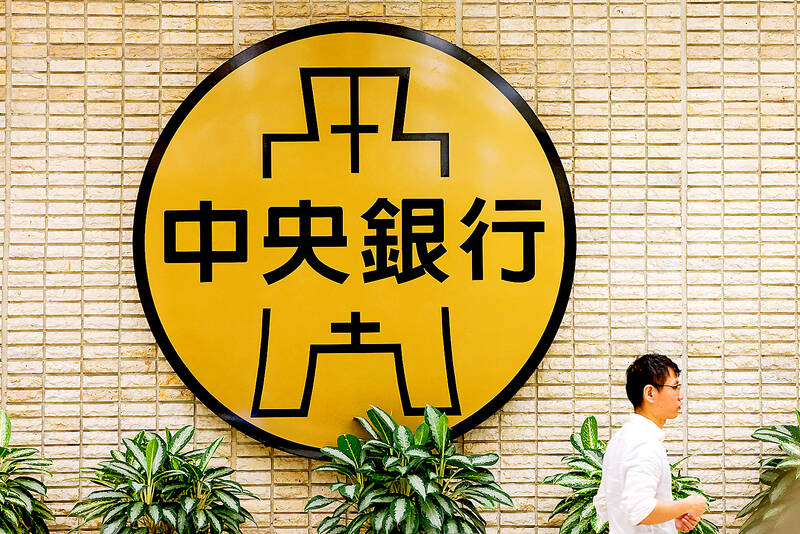The central bank is expected to keep its key interest rates unchanged for the sixth consecutive quarter at a policymaking meeting scheduled for Thursday next week, as uncertainties stemming from US tariff policies persist despite a strong likelihood of a rate cut by the US Federal Reserve this month, economists said.
Cathay United Bank Co (國泰世華銀行) chief economist Lin Chi-chao (林啟超) said that the central bank needs more time to assess how Taiwan’s exports would perform following the US’ “reciprocal” tariffs — which took effect on Aug. 7 and include a 20 percent levy on Taiwanese goods — before deciding on monetary policy.
The central bank is likely to wait until December, when more economic data is available, before considering an adjustment to rates, Lin said.

Photo: Ann Wang, Reuters
In June, the central bank left its policy rate unchanged, with the local discount rate holding at 2 percent — the highest in 15 years.
While US tariffs have weighed on some traditional industries, Taiwan’s technology sector has remained resilient, continuing to expand capital spending to meet global demand, Lin said.
That prompted the Directorate-General of Budget, Accounting and Statistics to raise its GDP growth forecast for this year to 4.45 percent from 3.10 percent, he said.
“It is hard for the central bank to follow the Fed and cut interest rates now,” Lin said. “The bank needs more economic data to evaluate when to begin a preventive rate-cut cycle.”
Agreeing with Lin, Wu Meng-tao (吳孟道), director of the sixth research division at the Taiwan Institute of Economic Research (台灣經濟研究院), said he does not expect the central bank to ease monetary policy until the first quarter of next year.
Wu added that a Section 232 investigation launched by Washington in April under the US Trade Expansion Act of 1962 could pave the way for tariffs on semiconductors.
Even if Taiwan Semiconductor Manufacturing Co (台積電) and other industry heavyweights with US investments secure exemptions, many smaller firms in the supply chain might not, he said.
“If the central bank cuts interest rates now, it will have fewer tools later to mitigate the impact of potential semiconductor tariffs,” he said.
Meanwhile, market observers said it would be worth watching how the central bank responds to the government’s move to ease rules on the “mortgage program 2.0” for young first-time homebuyers, which was launched in August 2023.
Last week, the Cabinet announced that mortgages under the subsidy program would be excluded from restrictions under the Banking Act (銀行法), which caps the total value of loans extended for residential and commercial construction at 30 percent of a bank’s total deposits and issued debentures.
The eased rules would allow banks to extend more mortgages to young borrowers, supporting the housing market and pushing up home prices.
In September last year, the central bank imposed a seventh round of selective credit controls, which property dealers described as the strictest in history, further capping homebuyer mortgage levels in an effort to rein in soaring housing prices.
However, Lin said the credit controls have so far proven effective, while the central bank also needs time to assess the impact of the relaxed mortgage rules.

With this year’s Semicon Taiwan trade show set to kick off on Wednesday, market attention has turned to the mass production of advanced packaging technologies and capacity expansion in Taiwan and the US. With traditional scaling reaching physical limits, heterogeneous integration and packaging technologies have emerged as key solutions. Surging demand for artificial intelligence (AI), high-performance computing (HPC) and high-bandwidth memory (HBM) chips has put technologies such as chip-on-wafer-on-substrate (CoWoS), integrated fan-out (InFO), system on integrated chips (SoIC), 3D IC and fan-out panel-level packaging (FOPLP) at the center of semiconductor innovation, making them a major focus at this year’s trade show, according

DEBUT: The trade show is to feature 17 national pavilions, a new high for the event, including from Canada, Costa Rica, Lithuania, Sweden and Vietnam for the first time The Semicon Taiwan trade show, which opens on Wednesday, is expected to see a new high in the number of exhibitors and visitors from around the world, said its organizer, SEMI, which has described the annual event as the “Olympics of the semiconductor industry.” SEMI, which represents companies in the electronics manufacturing and design supply chain, and touts the annual exhibition as the most influential semiconductor trade show in the world, said more than 1,200 enterprises from 56 countries are to showcase their innovations across more than 4,100 booths, and that the event could attract 100,000 visitors. This year’s event features 17

EXPORT GROWTH: The AI boom has shortened chip cycles to just one year, putting pressure on chipmakers to accelerate development and expand packaging capacity Developing a localized supply chain for advanced packaging equipment is critical for keeping pace with customers’ increasingly shrinking time-to-market cycles for new artificial intelligence (AI) chips, Taiwan Semiconductor Manufacturing Co (TSMC, 台積電) said yesterday. Spurred on by the AI revolution, customers are accelerating product upgrades to nearly every year, compared with the two to three-year development cadence in the past, TSMC vice president of advanced packaging technology and service Jun He (何軍) said at a 3D IC Global Summit organized by SEMI in Taipei. These shortened cycles put heavy pressure on chipmakers, as the entire process — from chip design to mass

Germany is to establish its first-ever national pavilion at Semicon Taiwan, which starts tomorrow in Taipei, as the country looks to raise its profile and deepen semiconductor ties with Taiwan as global chip demand accelerates. Martin Mayer, a semiconductor investment expert at Germany Trade & Invest (GTAI), Germany’s international economic promotion agency, said before leaving for Taiwan that the nation is a crucial partner in developing Germany’s semiconductor ecosystem. Germany’s debut at the international semiconductor exhibition in Taipei aims to “show presence” and signal its commitment to semiconductors, while building trust with Taiwanese companies, government and industry associations, he said. “The best outcome